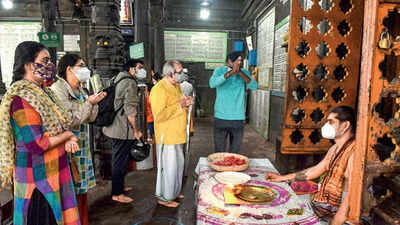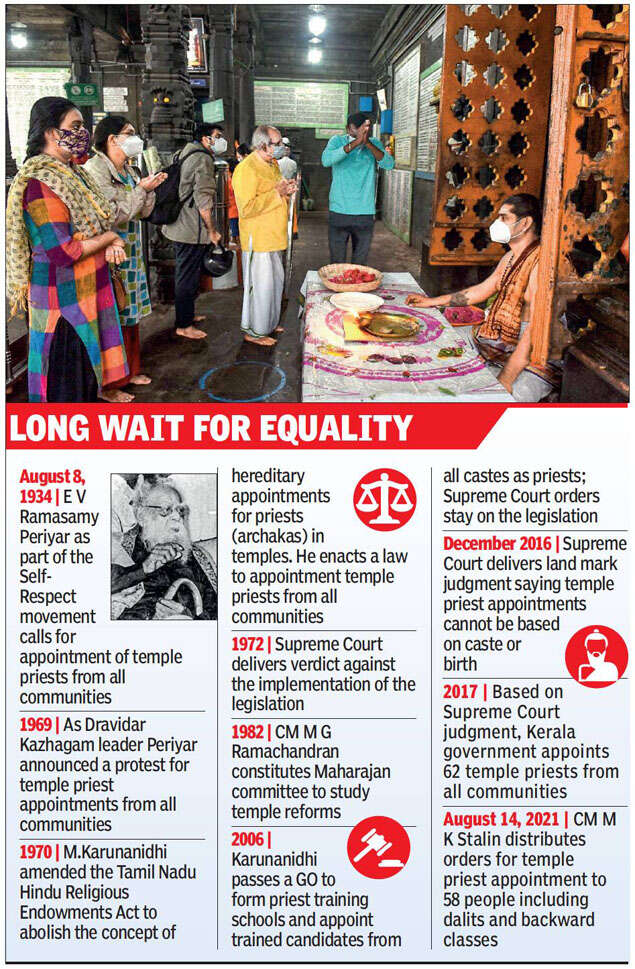Top Searches
- News
- City News
- chennai News
- Tamil Nadu temples open up by shutting door on caste bias
Tamil Nadu temples open up by shutting door on caste bias

By: N Ravikumar
CHENNAI: When Tamil Nadu chief minister M K Stalin distributed the appointment orders for priests in the state temples, a day before Independence Day, it was described as the fulfilment of more than an eightdecade dream of Dravidian movement’s founder EVR Periyar, who raised the demand in his daily ‘Kudiarasu’ on August 8, 1937.
The move evoked widespread celebrations among Periyarists as it was considered a much awaited legislation to free Hindu temples from brahmin domination, an objective of the Dravidian movement.

Paradoxically, the move fulfils the principles of Hindu saints like Sri Ramanuja Acharya and Swami Vivekananda who also wanted to ensure temple worship for all communities. This also removes a major ground cited for conversion from Hinduism to other religions like Christianity and Islam which allows people from all communities practising the faith to become priests.
The government’s step does not indicate a change or deviation of existing religious practice, but only a restoration of tradition, said Saivaite scholar M P Sathyavel Muruganar. The practice of nominating only brahmins as priests was imposed by the Vijaynagar emperors, who captured Tamil Nadu in the 16th century. There was no such discrimination before he asserted, and denied that there was any ‘agama’ stating that brahmins alone could be made temple priests.
“Anyone who attains ‘theetchai’ from a Sivacharya could be a priest and caste is not a qualification,” he said. Citing an example from Thiruvilaiyadarpuranam, a much revered Saivaite work narrating the history of 63 revered saints of Saivaite faith, he said “Appoodhi adigal, a Sivacharya by birth was given ‘theetchai’ by Saint Thirunavukkarasar, belonging to the Saiva Velalar community”.
The classical Sangam-age poems describe the priest in Muruga temples performing a ritual called ‘Velan Veriyaattam’. The priest performed ‘mari aruththal’ (goat sacrifice) and ‘kuruthi thooval’ (sprinkle its blood). The non-vegetarian priest of those days bear no resemblance to the brahmin priests of the six abodes of the same deity in Tamil Nadu.
The first attempt to appoint temple priests from all castes was made in 1970 by chief minister M Karunanidhi, but it fell through following a Supreme Court verdict. But, an apex court judgment, by a bench comprising Justice Ranjan Gogoi and Justice N V Ramana in 2015, gave a new lease of life to the much awaited temple reform when it observed that inclusion or exclusion as per the ‘agama shastras’ should not be based on the criteria of caste, birth or any other Constitutionally unacceptable barometers.
Following the verdict, the Kerala government overtook the Tamil Nadu government in appointing priests from all castes including dalits. Tamil Nadu becomes the second state to implement the reform, but this progressive legislation has been challenged in the Madras high court on the basis that appointment of priests should be done only on the basis of rules in the agama governing the temples. Advocate C Raju differs, he says only rituals can be governed by agama rules, “The appointment of priests by the government must be based on the law which ensures equality and there can be no discrimination based on caste or birth,” he said.
The DMK government’s Archaka Act, is a queer case of rationalists fulfilling the teachings of a revered Hindu saint Ramanuja, who offered ‘theetchai’ to all communities. Not a single political party including the major opposition AIADMK had opposed the move. It was the AIADMK founder M G Ramachandran, who appointed the Maharajan commission, which recommended that people from all castes be appointed as archakas. The BJP, too, welcomed the appointment of trained priests to the temples.
However, a section of priests had approached the Madras high court. Reacting to the opposition, Kolathur Mani, founder of the Dravidar Viduthalai Kazhagam said, “Aagamas bar ‘smarthas’ from entering some of the famous temples like Nellaiappar temple, but they are working as priests in some of the temples, which bar their entry.”
The opposition to reforms in Hinduism must have been more intense during the times of Vivekananda since he had said, “Fleshless and bloodless skeletons of the dead body of past India, …. on your bony fingers are some priceless rings of jewel, treasured up by your ancestors, and within the embrace of your stinking corpses are preserved a good many ancient treasure-chests. Up to now you have not had the opportunity to hand them over. Skeletons of the past, there, before you, are your successors, the India that is to be. Throw those treasure-chests of yours and those jewelled rings among them …. No sooner will you disappear than you will hear the inaugural shout of Renaissant India.”
(The writer is a freelance journalist)
CHENNAI: When Tamil Nadu chief minister M K Stalin distributed the appointment orders for priests in the state temples, a day before Independence Day, it was described as the fulfilment of more than an eightdecade dream of Dravidian movement’s founder EVR Periyar, who raised the demand in his daily ‘Kudiarasu’ on August 8, 1937.
The move evoked widespread celebrations among Periyarists as it was considered a much awaited legislation to free Hindu temples from brahmin domination, an objective of the Dravidian movement.

Paradoxically, the move fulfils the principles of Hindu saints like Sri Ramanuja Acharya and Swami Vivekananda who also wanted to ensure temple worship for all communities. This also removes a major ground cited for conversion from Hinduism to other religions like Christianity and Islam which allows people from all communities practising the faith to become priests.
The government’s step does not indicate a change or deviation of existing religious practice, but only a restoration of tradition, said Saivaite scholar M P Sathyavel Muruganar. The practice of nominating only brahmins as priests was imposed by the Vijaynagar emperors, who captured Tamil Nadu in the 16th century. There was no such discrimination before he asserted, and denied that there was any ‘agama’ stating that brahmins alone could be made temple priests.
“Anyone who attains ‘theetchai’ from a Sivacharya could be a priest and caste is not a qualification,” he said. Citing an example from Thiruvilaiyadarpuranam, a much revered Saivaite work narrating the history of 63 revered saints of Saivaite faith, he said “Appoodhi adigal, a Sivacharya by birth was given ‘theetchai’ by Saint Thirunavukkarasar, belonging to the Saiva Velalar community”.
The classical Sangam-age poems describe the priest in Muruga temples performing a ritual called ‘Velan Veriyaattam’. The priest performed ‘mari aruththal’ (goat sacrifice) and ‘kuruthi thooval’ (sprinkle its blood). The non-vegetarian priest of those days bear no resemblance to the brahmin priests of the six abodes of the same deity in Tamil Nadu.
The first attempt to appoint temple priests from all castes was made in 1970 by chief minister M Karunanidhi, but it fell through following a Supreme Court verdict. But, an apex court judgment, by a bench comprising Justice Ranjan Gogoi and Justice N V Ramana in 2015, gave a new lease of life to the much awaited temple reform when it observed that inclusion or exclusion as per the ‘agama shastras’ should not be based on the criteria of caste, birth or any other Constitutionally unacceptable barometers.
Following the verdict, the Kerala government overtook the Tamil Nadu government in appointing priests from all castes including dalits. Tamil Nadu becomes the second state to implement the reform, but this progressive legislation has been challenged in the Madras high court on the basis that appointment of priests should be done only on the basis of rules in the agama governing the temples. Advocate C Raju differs, he says only rituals can be governed by agama rules, “The appointment of priests by the government must be based on the law which ensures equality and there can be no discrimination based on caste or birth,” he said.
The DMK government’s Archaka Act, is a queer case of rationalists fulfilling the teachings of a revered Hindu saint Ramanuja, who offered ‘theetchai’ to all communities. Not a single political party including the major opposition AIADMK had opposed the move. It was the AIADMK founder M G Ramachandran, who appointed the Maharajan commission, which recommended that people from all castes be appointed as archakas. The BJP, too, welcomed the appointment of trained priests to the temples.
However, a section of priests had approached the Madras high court. Reacting to the opposition, Kolathur Mani, founder of the Dravidar Viduthalai Kazhagam said, “Aagamas bar ‘smarthas’ from entering some of the famous temples like Nellaiappar temple, but they are working as priests in some of the temples, which bar their entry.”
The opposition to reforms in Hinduism must have been more intense during the times of Vivekananda since he had said, “Fleshless and bloodless skeletons of the dead body of past India, …. on your bony fingers are some priceless rings of jewel, treasured up by your ancestors, and within the embrace of your stinking corpses are preserved a good many ancient treasure-chests. Up to now you have not had the opportunity to hand them over. Skeletons of the past, there, before you, are your successors, the India that is to be. Throw those treasure-chests of yours and those jewelled rings among them …. No sooner will you disappear than you will hear the inaugural shout of Renaissant India.”
(The writer is a freelance journalist)
FacebookTwitterLinkedinEMail
Start a Conversation
end of article

